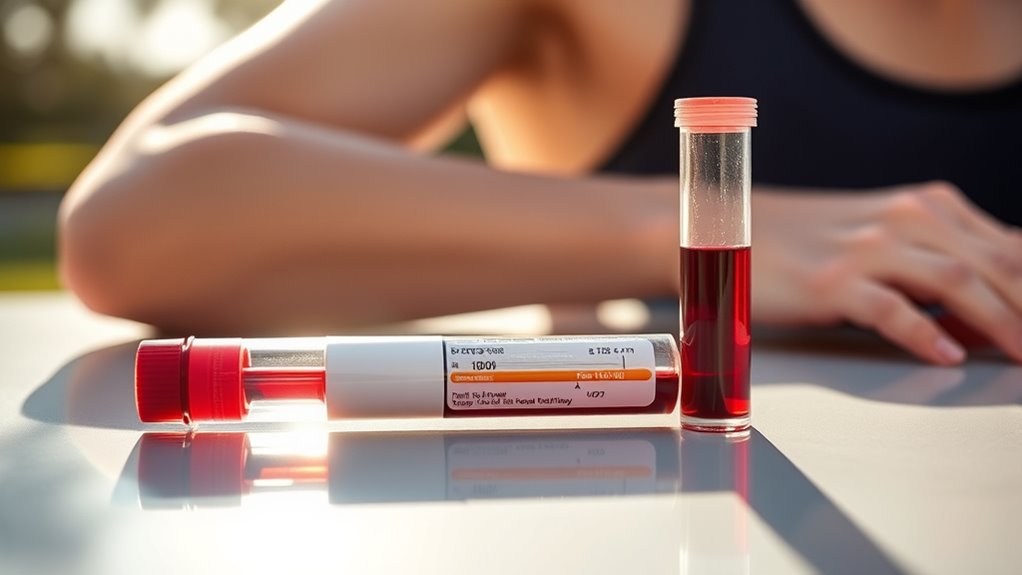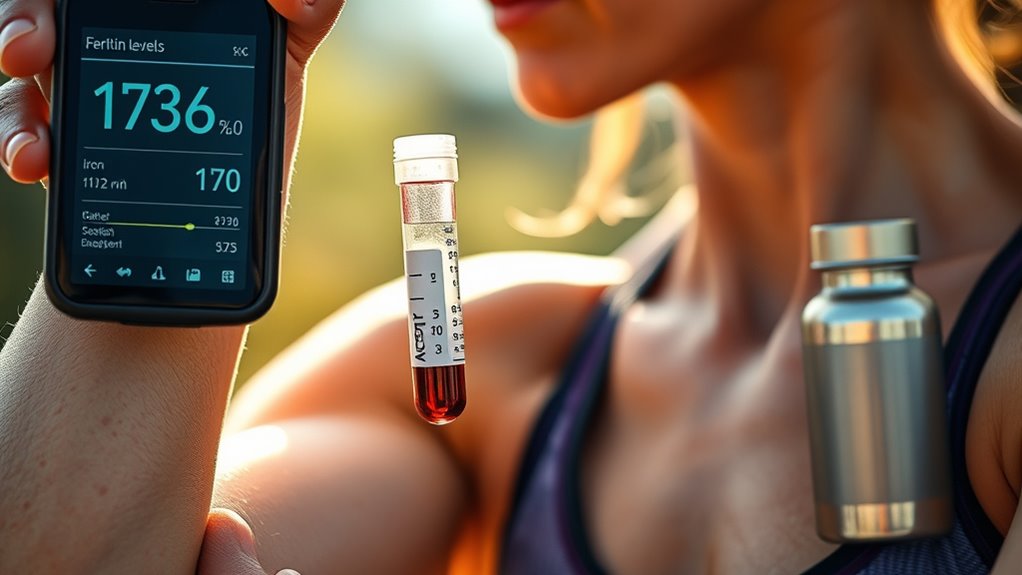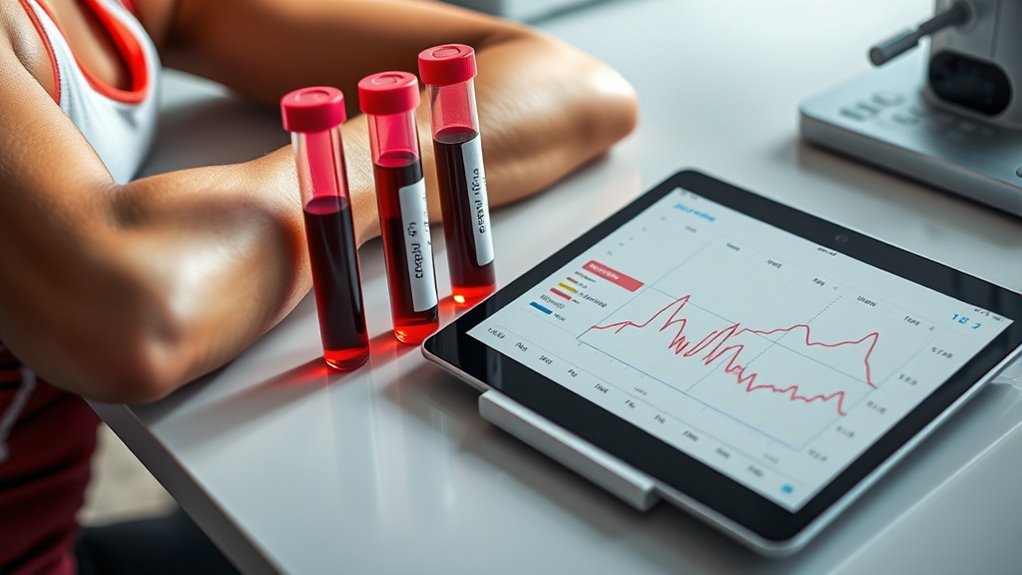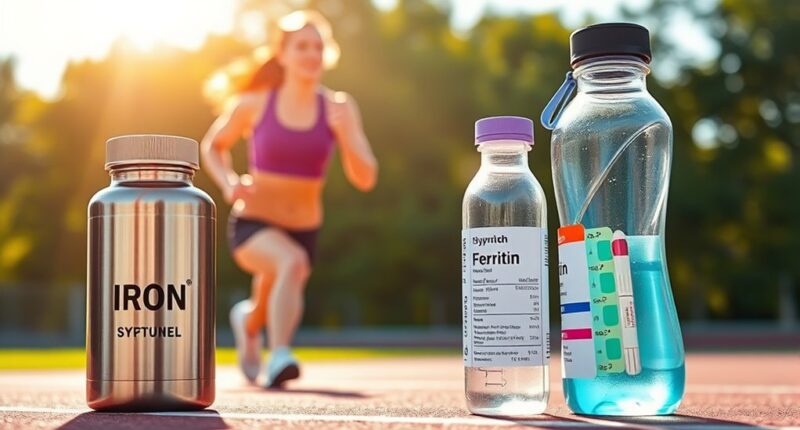To stay at your best, get your iron levels checked regularly through blood tests like ferritin and CBC, especially if you experience fatigue or decreased performance. Focus on iron-rich foods paired with vitamin C to boost absorption, and avoid drinking tea or coffee during meals. Monitoring your menstrual health is also important. If results show low ferritin or anemia signs, consult a healthcare professional for personalized strategies to improve your iron stores and athletic output.
Key Takeaways
- Regular blood testing of ferritin and CBC helps monitor iron status and detect deficiencies early.
- Maintain a diet rich in iron and vitamin C, and avoid tannins and calcium during iron-rich meals to optimize absorption.
- Recognize symptoms like fatigue, dizziness, and shortness of breath as signs of potential iron deficiency or anemia.
- Adjust training load during periods of low ferritin levels and seek medical advice for personalized supplementation if needed.
- Schedule testing in the morning fasting, during intense training phases, and avoid during illness for accurate iron status assessment.
The Role of Iron and Ferritin in Female Running Performance

Iron is essential for female runners because it helps produce hemoglobin, which transports oxygen to your muscles during exercise. Proper iron absorption is vital for maintaining peak performance, especially when your iron stores are low. Ferritin, the protein that stores iron, plays a key role in ferritin regulation, ensuring your body can access iron when needed. When ferritin levels are adequate, your muscles receive enough oxygen, supporting endurance and recovery. Conversely, inadequate iron absorption can lead to decreased ferritin levels, impairing oxygen transport and causing fatigue. Monitoring ferritin helps you understand how well your body manages iron, allowing you to take targeted steps to optimize ferritin regulation. This balance boosts your stamina, prevents deficiencies, and keeps you running at your best. Additionally, understanding the contrast ratio of your training environment can help optimize your performance by creating ideal conditions for endurance.
Recognizing Symptoms of Iron Deficiency and Anemia

You might notice you’re feeling unusually tired or weak, which can be signs of iron deficiency or anemia. Dizziness or lightheadedness during or after your runs are also common indicators. Recognizing these symptoms early helps you take action to maintain your performance and health. Incorporating regular blood tests can help detect deficiencies before they impact your running.
Common Symptom Indicators
Recognizing the symptoms of iron deficiency and anemia is essential for female runners, as these conditions can greatly impact performance and overall health. You might notice:
- Unusual fatigue that lingers despite rest, making every run feel harder.
- Pale skin or cold hands, signals your body struggles to deliver oxygen.
- Shortness of breath during activity, even without pushing too hard.
- Cravings for non-food items or difficulty absorbing nutrients due to dietary restrictions, affecting iron levels.
- Being aware of AI safety concerns can help in understanding how technological tools used for health monitoring are continuously improved for accuracy and safety. Additionally, understanding personality traits can help identify emotional factors that contribute to health challenges.
Pay close attention to supplement timing, which can influence absorption. If you’re experiencing these signs, addressing dietary restrictions and ensuring proper supplement intake can make a significant difference. Recognizing these indicators early helps you stay strong and on track.
Fatigue and Weakness
Persistent fatigue and weakness are common signs that your body isn’t getting enough iron, which can hinder your running performance and recovery. When iron absorption is low, your body struggles with hemoglobin synthesis, reducing oxygen delivery to muscles. This results in feelings of exhaustion and muscle weakness, even after rest. Recognizing these symptoms early helps you address deficiencies before they worsen. Incorporating low carb foods that are rich in iron, like meats and leafy greens, can support your efforts to improve iron levels. Understanding iron deficiency is crucial in managing and preventing these issues effectively. Additionally, engaging in regional culinary traditions can introduce you to diverse iron-rich dishes that enhance your diet. Optimizing your diet with nutrient-dense foods further aids in replenishing iron stores and boosting overall energy levels.
Dizziness and Lightheadedness
When your iron levels drop, symptoms often extend beyond fatigue and weakness to include dizziness and lightheadedness. These sensations can make you feel unsteady, anxious, and worried about your safety during runs. Recognizing these signs is vital, especially since they may signal iron deficiency or anemia.
You might experience:
- Feeling faint when standing up too quickly
- A spinning sensation that disrupts your focus
- Sudden drops in energy affecting your mental clarity
- Increased vulnerability to stress, impacting mental health awareness
To combat this, prioritize hydration strategies and make certain you’re fueling your body properly. Addressing these symptoms early can improve your well-being and keep you confident on your runs.
Key Blood Tests to Assess Iron Status

To accurately assess your iron status, several key blood tests are essential. First, a serum ferritin test measures your stored iron levels, indicating if you’re at risk of deficiency. A complete blood count (CBC) reveals details about your red blood cells and can detect anemia. Including tests for serum iron and total iron-binding capacity (TIBC) helps evaluate how much iron circulates and how effectively your blood transports it. Your dietary iron intake influences these results, so consider how your nutrition supports your needs. Blood donation, whether recent or frequent, can temporarily lower iron stores, making testing vital for runners. Additionally, understanding your iron absorption capacity can help tailor dietary strategies and supplementation if needed. Incorporating holistic approaches like somatic therapy techniques may support overall physical and emotional well-being during recovery. Together, these tests give a thorough picture of your iron health, guiding effective tactics to maintain prime performance and recovery.
How to Prepare for Iron Testing

Preparing for iron testing involves simple steps to guarantee accurate results. First, avoid taking ferritin supplements or iron-rich foods at least 24 hours before your test to prevent skewed levels. Second, stay well-hydrated; dehydration can affect blood flow and test accuracy. Third, schedule your test early in the morning, as fasting helps provide clearer baseline results. Fourth, communicate openly with your healthcare provider about any supplements or medications you’re taking that might influence your iron or ferritin levels. By following these steps, you assure your test reflects your true iron status. Proper preparation can help you make informed decisions about diet, supplements, and training adjustments tailored to your needs as a female runner.
Interpreting Ferritin and Iron Test Results

Interpreting your ferritin and iron test results can reveal important insights into your overall health and athletic performance. Low ferritin levels often indicate insufficient iron stores, which can impair iron absorption and hinder oxygen delivery to muscles. Elevated ferritin may suggest inflammation or other health issues, affecting ferritin regulation. Understanding these results helps you identify if your body is effectively absorbing iron or if there’s a disruption in ferritin regulation. Keep in mind that ferritin levels can fluctuate due to factors like inflammation, so it’s essential to interpret results within the broader context of your health and training. Accurate interpretation enables you to assess whether your iron levels support ideal performance or if adjustments are necessary to prevent fatigue and improve recovery.
Strategies to Naturally Boost Iron Levels

Increasing your iron levels naturally begins with adjusting your diet to include more iron-rich foods. Focus on foods like lean meats, leafy greens, legumes, and fortified cereals. To boost your intake effectively, consider these strategies:
- Incorporate iron-rich foods into every meal to maintain steady levels.
- Pair iron-rich foods with vitamin C sources, like citrus or peppers, to enhance absorption.
- Use herbal supplements such as nettle or yellow dock to support iron intake naturally.
- Avoid drinking tea or coffee during meals, as tannins can inhibit iron absorption.
When to Consider Supplementation and Medical Advice

If you notice symptoms like fatigue, dizziness, or shortness of breath, it might be time to contemplate medical advice. Testing at the right moments, such as after a period of intense training, can help identify deficiencies early. Don’t hesitate to seek professional guidance if your ferritin levels are low or symptoms worsen.
Symptoms Indicating Deficiency
When you notice persistent fatigue, weakness, or difficulty maintaining your usual pace during runs, these could be signs of ferritin deficiency. Pay attention to these symptoms:
- Unexplained exhaustion that lingers despite rest.
- Cold hands and feet, even in warm weather.
- Dizziness or lightheadedness during or after workouts.
- Pale skin or brittle nails that seem off for you.
If these symptoms appear, consider boosting your intake of iron-rich foods like lean meats, spinach, and legumes. Pair them with vitamin C supplementation or sources such as citrus fruits to enhance iron absorption. Don’t ignore these signs—consult a healthcare professional for testing and personalized advice. Early action can prevent more serious deficiencies.
Optimal Testing Timing
Noticing symptoms of ferritin deficiency warrants timely testing to determine whether supplementation is necessary. The best time to test is when your iron absorption is ideal, usually in the morning before meals, as absorption varies throughout the day. Testing during periods of increased training load or after intense workouts can reveal depleted ferritin storage. Avoid testing during inflammation or illness, which can skew results. Regular testing every few months helps track trends, especially if you’re experiencing symptoms or preparing for peak training. Recognizing the right timing ensures accurate results, guiding you on whether to adjust your diet or start supplements. Proper timing supports maintaining healthy ferritin levels, essential for energy, endurance, and overall performance.
When to Seek Medical Care
You should seek medical advice and consider supplementation if your ferritin levels are consistently below the recommended range, especially if you experience symptoms like fatigue, weakness, or decreased performance. Ignoring these signs can lead to serious health issues. Consider these steps:
- Prioritize iron-rich foods such as lean meats, spinach, and beans to boost ferritin naturally.
- Avoid frequent blood donation if your ferritin is low, as it depletes iron stores further.
- Consult a healthcare professional for appropriate testing and personalized guidance.
- Monitor your symptoms closely—persistent tiredness or poor recovery signals the need for medical intervention.
Addressing low ferritin early can prevent setbacks in your training and overall health. Don’t wait—your body needs proper care.
Lifestyle Tips to Maintain Optimal Iron Stores

Maintaining essential iron stores is crucial for female runners, as iron plays a key role in oxygen transport and energy production. To support this, include iron rich foods like lean meats, leafy greens, and fortified grains in your diet. Pair these foods with vitamin C-rich options, such as citrus or peppers, to enhance iron absorption. Avoid consuming calcium-rich foods or supplements at the same time as iron-rich meals, as calcium can inhibit iron absorption. Stay mindful of your menstrual health and monitor any symptoms of deficiency, like fatigue or dizziness. Regularly check your ferritin levels if you’re training intensely or experiencing symptoms. By making strategic dietary choices and timing your nutrient intake, you can effectively maintain your iron stores and support ideal performance.
Frequently Asked Questions
Can Vegetarian Diets Impact Iron Levels in Female Runners?
A vegetarian diet can impact your iron levels because plant-based iron, or non-heme iron, isn’t absorbed as efficiently as animal sources. You might notice lower energy or endurance if your nutrient absorption isn’t optimized. To improve this, include vitamin C-rich foods to enhance absorption and avoid tea or coffee during meals, which can inhibit iron uptake. Proper planning guarantees you maintain healthy iron levels for your running performance.
How Does Menstruation Affect Iron Requirements for Female Athletes?
Imagine a gentle stream, steadily flowing, yet sometimes spilling over its banks—that’s how menstruation affects your iron needs. Menstrual blood loss can lead to iron depletion, making it vital to augment your intake to maintain energy and performance. You might notice increased fatigue or decreased endurance. Staying mindful of your body’s signals and adjusting your diet or supplementation helps ensure you stay strong and resilient during your athletic journey.
Are There Risks Associated With Iron Supplementation Without Medical Supervision?
Taking iron supplements without medical supervision can be risky because you might experience self-medication risks, such as taking the wrong dose or using inappropriate forms. Overdosing on iron can lead to serious health issues like toxicity or organ damage. Always consult a healthcare professional before supplementing, because supplement overdose isn’t just ineffective—it can harm your body. Proper testing and guidance guarantee you’re safely meeting your iron needs.
How Quickly Can Iron Levels Improve With Diet Changes or Supplements?
Like a slow sunrise, iron levels can improve gradually with diet changes or supplements. You might see some progress within a few weeks, but full recovery often takes 2-3 months. Iron absorption varies based on your intake and supplement timing—taking iron on an empty stomach can boost absorption, but may cause discomfort. Consistency and patience are key, and consulting a healthcare professional guarantees safe, effective progress.
What Are Long-Term Health Effects of Iron Deficiency in Female Runners?
You should know that long-term iron deficiency can negatively impact your health, especially in female runners. It can lead to decreased bone density, increasing fracture risk, and impair your cardiovascular health, making it harder to sustain intense activity. Over time, these issues can cause fatigue, weakness, and lower performance. Addressing iron deficiency early helps protect your bones and heart, ensuring you stay healthy and able to train effectively.
Conclusion
Think of your iron and ferritin levels as the fuel that keeps your running engine strong. When you prioritize testing, proper nutrition, and smart strategies, you guarantee your body runs smoothly mile after mile. Ignoring these signs is like trying to run on empty—eventually, you’ll hit a wall. Stay proactive, listen to your body, and keep your internal tank full. Your best run is ahead when you nurture your iron stores with care and awareness.









